
The Democratic Republic of Congo (DRC)’s last herd of zebra run free in Upemba. Photo courtesy of the FZS.
Zebra racing across the yellow-green savannah is an iconic image for Africa, but imagine you’re seeing this not in Kenya or South Africa, but in the Democratic Republic of Congo (DRC). Welcome to Upemba National Park: once a jewel in the crown of African wildlife, this protected area has been decimated by civil war. Now, a new bold initiative by the Frankfurt Zoological Society (FZS), dubbed Forgotten Parks, is working to rehabilitate Upemba after not only decades of conflict but also poaching, neglect, and severe poverty.
“At one time, Upemba was home to large herds of elephant, zebra, buffalo and antelope. In fact this region was known in the days of early European explorers as a center for ivory,” FSZ’s project leader for Upemba, Alan Deverell, explains to mongabay.com “However, the park has suffered during Congo’s decades of civil strife. The parks were largely neglected and poaching flourished. While many of the species that once populated the park are still present, their numbers are now extremely low. Sadly, most of the large predators are gone due to hunting and lack of prey.”
But the zebra are still there—the only herd in the DRC. In addition, the park is home to a unique antelope species, the Upemba lechwe (Kobus anselli) listed as Critically Endangered by the IUCN Red List, two endemic birds, and at least ten endemic amphibians. Recent research has also discovered five species that may be new to science.
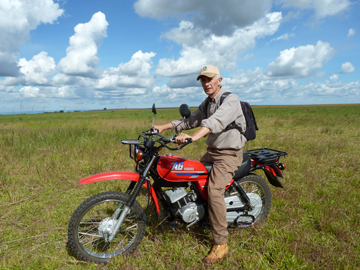 Alan Deverell in Upemba. Photo courtesy of the FZS. |
Deverell’s mission to conserve remaining wildlife is a herculean one. He says when he arrived the park was “pitiful”: infrastructure falling apart, roads gone, and tourists absent for decades.
“The rangers themselves were living in deplorable conditions,” he adds (see videos at end of the article). “Poorly paid and under-resourced, they had been abandoned to their own devices. Many had turned to poaching and other illegal activities in order to feed their families.” In the year-and-a-half that the program has been up and running, the team has built a canteen for rangers to get food and a health facility for them and their families.
The threat of conflict is still a daily reality here, however. This summer, Upemba was attacked by Mai Mai rebels, who raided the park headquarters.
“Fortunately, I was able to negotiate with the attackers who were there primarily in search of arms and provisions,” says Deverell. “As it turned out, we got off quite lightly. Unlike the attack in 2004, no one was killed or injured, very little was destroyed and most of the equipment that was stolen can be replaced.”
In 2004, the park lost seven people to a similar raid.
Still, despite ongoing instability in the DRC, Deverell is optimistic that the FZS ambitious program can make Upemba a conservation success again. Already, poaching has lessened and animals are returning. Rangers and their families have greater economic security, and are now taking part in various training programs and even creating local businesses.
“The ultimate goal is to restore the park to its former glory by providing training and logistical support for the rangers, rehabilitating the park infrastructure, developing a conservation strategy and eventually providing a new opportunities for tourists to experience Upemba,” Deverell says.
The Forgotten Parks program is also working in the DRC in Virunga and Maiko National Parks.
INTERVIEW WITH ALAN DEVERELL: UPEMBA NATIONAL PARK

Upemba in the wet season. Photo courtesy of the FZS. Click to enlarge.
Mongabay: Most people have probably never heard of Upemba National Park. Will you tell us about this place?
Alan Deverell: Upemba is one of the oldest and largest of Africa’s national parks. Founded in 1939, during Belgian colonial rule, it covers an area of approximately 10,000 square kilometres in Katanga province. It is bordered to the west by Lake Upemba and a number of smaller lakes. These constitute some of the most important wetlands on the continent. The park also offers some stunning landscapes, with its high-plateau savannah, deep gorges and rich gallery forest.
At one time, Upemba was home to large herds of elephant, zebra, buffalo and antelope. In fact this region was known in the days of early European explorers as a center for ivory. However, the park has suffered during Congo’s decades of civil strife. The parks were largely neglected and poaching flourished. While many of the species that once populated the park are still present, their numbers are now extremely low. Sadly, most of the large predators are gone due to hunting and lack of prey.
In early 2011 Frankfurt Zoological Society was invited into Upemba by the Congolese wildlife authority (ICCN) to manage a European Union fund for the rehabilitation of the park. We are the first international NGO to be based in the park. The ultimate goal is to restore the park to its former glory by providing training and logistical support for the rangers, rehabilitating the park infrastructure, developing a conservation strategy and eventually providing a new opportunities for tourists to experience Upemba.
Mongabay: How is Upemba different from other parks in the Democratic Republic of Congo (DRC)?
Alan Deverell: Upemba is a very different habitat from most of DRC’s other parks. It is savannah where the others are largely forest. The park is stunningly beautiful and the colors of the savannah change from season to season. Unlike a lot of the steamy jungle parks, it’s actually crisp and cool up on the plateau. There are some huge waterfalls as well and it could be an amazing spot for tourists, even for things like horseback riding or mountain biking. This habitat also means a different assemblage of wildlife than is found in other parks. For example, it’s the only national park in the country with zebra.
Mongabay: What are some of the notable species in the park?
Alan Deverell: The zebra, though common in other parts of east and southern Africa, are unique in Congo. While their numbers have been whittled down to 30 or so individuals, these numbers are on the increase due to the success of recent conservation efforts. Upemba was known for large herds of elephants, as well as lions, rhino, leopard, cheetah and painted dog. In fact, it was a “big five” park at one time. While elephants were believed to have disappeared from the region, recently a group of approximately 100 individuals has been discovered in an area of marshland to the northwest of the park, and a smaller group of 20 or so in the park annex. These are the last remaining elephants in the province that we know of. We would very much like them to return to their natural habitat in the park. However a village, known to be home to poachers and armed groups, now sits in the middle of the corridor used by the elephants along the Lufira River. Ideally, a negotiation will be made to clear the illegal settlements so wildlife can move through that area of the park again.
Luckily, much of the ecosystem remains intact and the park is renowned for its high levels of biodiversity and endemic species. The park is still extremely rich in birdlife, small vertebrates, insects and reptiles. One antelope, the Upemba Lechwe, and at least two species of birds are only found here.
SAVING A PARK
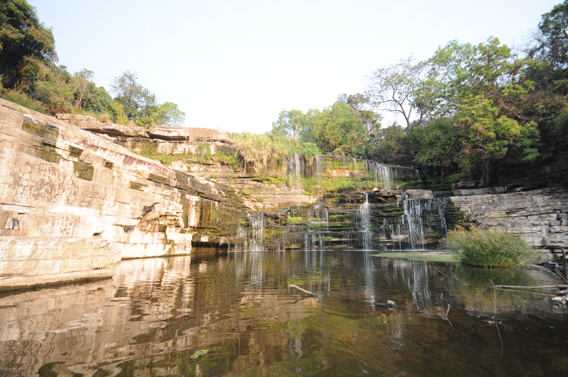
When still a tourist destination, Upemba was known for its marvelous waterfalls. Photo courtesy of the FZS.
Mongabay: What was the state of the park when you arrived?
Alan Deverell: After decades of neglect, warfare and uncontrolled poaching, the park was in a pitiful state. The infrastructure was in an advanced state of disrepair. Roads and tracks were overgrown, bridges had collapsed, and buildings were totally dilapidated. A hydro-power turbine installed in 1948 had not worked for years and the water system serving the station had broken down. No tourists have visited the park since the 1990’s and very few visitors in recent years have bothered to make the arduous journey along the region’s deplorable roads.
The rangers themselves were living in deplorable conditions. Poorly paid and under-resourced, they had been abandoned to their own devices. Many had turned to poaching and other illegal activities in order to feed their families.
Over the last 18 months FZS has invested a lot of energy into restoring the infrastructure, paying and equipping the rangers and improving the living conditions of the park staff and their families.
Mongabay: Recently conflict came to Upemba again. What are your comments around this incident—how did you manage to control the situation and not let things escalate?
Alan Deverell: Indeed, on July 21st a group of about 30 heavily-armed Mai-Mai rebels attacked Upemba’s headquarters at Lusinga. When the park rangers retreated our team was left alone with some of the women and children. Fortunately, I was able to negotiate with the attackers who were there primarily in search of arms and provisions. Basically, these are desperate young men from surrounding communities who have been caught up in a protracted struggle for power in the province. They are implicated in much of the poaching activity in the park. As it turned out, we got off quite lightly. Unlike the attack in 2004, no one was killed or injured, very little was destroyed and most of the equipment that was stolen can be replaced.
Mongabay: How do you prevent such attacks, especially like the one that hit the ranger station in 2004 killing seven?
Alan Deverell: Clearly the events of 21st July have shown that there is still much to be done. While the attack in June 2004 may have been far more destructive, the basic issues remain the same. These are issues engendered by poverty and the struggle for control over resources within the park.
Preventing such attacks in the future depends on resolving some of the political and resource management issues that are still prevalent. It means dealing with corruption and the involvement of powerful local figures in all manner of illegal activities. It requires transforming the park guards into something resembling the sort of professional and well-equipped ranger forces that exist in other parts of Africa. Some of these things are the within the frame of work of FZS, but others require a larger, political solution that can only come with time and a concerted effort on the part of Congolese leadership and local individuals. In the mean time, we try to encourage an open dialog with local communities, support local development initiatives where possible, build the capacity of the rangers and support park leadership to develop links to important stakeholders.
Mongabay: Much of the poaching has been done by rangers to feed their families, how are you working to change this long-established practice?
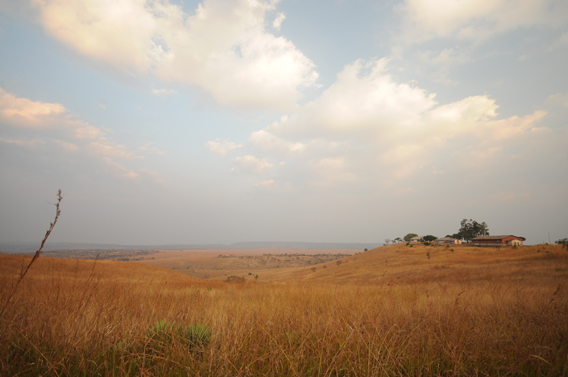
Upemba headquarters: Lusinga. Photo courtesy of the FZS.
Alan Deverell: At a very basic level we have worked to improve the living and working conditions of the rangers, and provide access, through a canteen, to food so that the rangers have a choice not to hunt in order to eat. The essential task is then to develop a well-equipped, professionally-trained and loyal ranger force. We need to instill a sense of pride in the ranger service so that they become defenders of the park, and not its adversaries. As an initial step, we started paying salary supplements to all the rangers, and supporting frequent patrols in the park to discourage outside poachers. Part of this work is also rebuilding the management structure of the park. Many of the officers and senior staff lack skills and training to carry out the functions to which they have been appointed. So building capacity, even for basic skills like using a GPS or writing a patrol report, is key to ensuring that this park will function properly.
Ideally, once the park is functional and can generate fees from visitors, its rangers and families will have a steady source of revenue and will no longer have to rely on the park’s resources for food and income.
Mongabay: Recently, you’ve built a health centre and canteen for rangers and their families. How will this help the park?
Alan Deverell: These two initiatives have probably done most in the short-term to diminish the incidence of poaching in the park, particularly on the part of the rangers. The rangers themselves openly admit that they have reduced their poaching activities as a result of the support that is now being offered to them. Indeed, we are seeing wildlife return to this part of the park and much reduced evidence of poaching activity.
The health center is both physically and emotionally beneficial. People can’t work if they are sick. Even simple things like intestinal parasites can put rangers out of work for a few days. Treatments for malaria, infections and parasites can go a long way to keeping the staff up and running. But furthermore, the clinic treats the rangers’ families. They see this access to health care, especially for children and pregnant wives, as a major benefit of the project and their work. I’m not sure we can quantify how much that counts towards their willingness to do their jobs well, but I have no doubt that it is important.
Mongabay: What has been the response from the rangers and their families to the new infrastructure?
Alan Deverell: Phase one of the work has provided a vital injection of cash into the local economy, with a number of the rangers and their wives being employed to carry out the reconstruction of roads and other infrastructure. This has meant a direct improvement in living standards. It has also meant a number of personnel have been fully occupied, who might otherwise be involved in activities less beneficial to the park. Also, now that people are being paid and have access to electricity, some of the wives and local women have also started small businesses, like sewing or selling various items.
Mongabay: What are the major health risks for families in the area?
Alan Deverell: Malaria is a huge problem and accounts for an enormous loss of productivity amongst the working population. Some diseases that might be considered fairly innocuous in more developed countries are major killers in this area. Amongst these are measles and dysentery, which go some way to account for the elevated level of infant mortality. Much of the disease however is easily preventable since it is directly linked to a lack of hygiene and poor nutrition. This is why initiatives such as the food store are so important. We have also started a regular series of training sessions with the ranger’s wives to teach them about hygiene and improving nutrition for their families.
Mongabay: What kind of training will rangers be undergoing?
Alan Deverell: We will be bringing in outside expertise to put the rangers through an intensive training program after a strict selection process. This will include training in a number of areas including; advanced surveillance techniques, law enforcement, and the use of supporting equipment.
UPEMBA RESEARCH AND NEW SPECIES
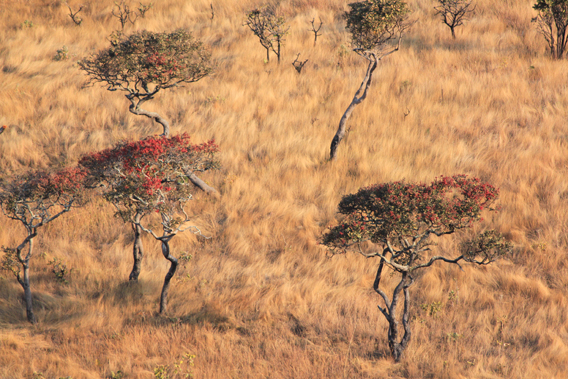
The dry season brings autumnal colors to Upemba. Photo courtesy of the FZS.
Mongabay: What research efforts are currently being undertaken at the park?
Alan Deverell: Two research projects have been carried out while FZS has been working in the park. The first is a study on the bushmeat trade by a Congolese zoologist to determine the species most commonly poached and to survey local communities on attitudes to the bush meat trade. More recently, a group of visiting biologists conducted surveys in the wetland areas around the park headquarters in Lusinga (see videos below). They identified hundreds of reptiles, amphibians and insects, some of which had not been seen for over 50 years. They also discovered five species that are believed to be new to science! Their research revealed that while the larger mammals may be rare, “smaller creatures” exist in Upemba in amazing abundance and diversity.
Mongabay: What happens once this program ends?
Alan Deverell: This is the hardest question for any conservation or development program. We are currently assisting the ICCN in drawing up a management plan for the park. An essential part of this will include a blueprint for assuring long-term sustainability. It is vital during the lifetime of the project that we build capacity within the Congolese wildlife authority as well as establish a solid foundation that can support their future work. We are also looking for other funding opportunities of this wilderness area. One of our key objectives is to create interest in Upemba both locally and internationally. If this extraordinary wilderness area is to survive, it is vital that people once again visit the park and rediscover its natural wonders.

More waterfalls in Upemba. Photo courtesy of the FZS.
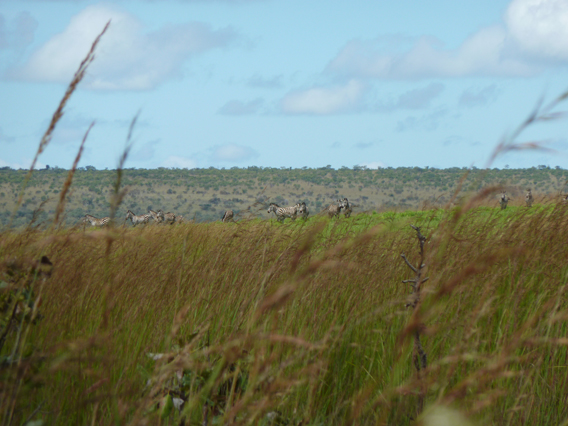
Upemba’s zebras. Photo courtesy of the FZS.
Related articles
Remarkable new monkey discovered in remote Congo rainforest

(09/12/2012) In a massive, wildlife-rich, and largely unexplored rainforest of the Democratic Republic of the Congo (DRC), researchers have made an astounding discovery: a new monkey species, known to locals as the ‘lesula’. The new primate, which is described in a paper in the open access PLoS ONE journal, was first noticed by scientist and explorer, John Hart, in 2007. John, along with his wife Terese, run the TL2 project, so named for its aim to create a park within three river systems: the Tshuapa, Lomami and the Lualaba (i.e. TL2), a region home to bonobos, okapi, forest elephants, Congo peacock, as well as the newly-described lesula.
Gang raids remote national park in the Democratic Republic of the Congo
(07/26/2012) Mai mai rebels, likely linked to poachers, raided the headquarters of the remote Upemba National Park last weekend, reports the Frankfurt Zoological Society (FZS) which is working to rehabilitate the park in the Democratic Republic of the Congo (DRC). Fortunately, no one was injured in the raid, but equipment was stolen. The raid comes only a few weeks after a different group of rebels murdered seven people and shot dead 13 captive okapis at the Okapi Wildlife Reserve.
Innovative conservation: bandanas to promote new park in the Congo
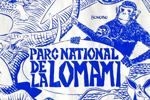
(07/16/2012) American artist, Roger Peet—a member of the art cooperative, Justseeds, and known for his print images of vanishing species—is headed off to the Democratic Republic of the Congo (DRC) to help survey a new protected area, Lomami National Park. With him, he’ll be bringing 400 bandanas sporting beautifully-crafted images of the park’s endangered fauna. Peet hopes the bandanas, which he’ll be handing out freely to locals, will not only create support and awareness for the fledgling park, but also help local people recognize threatened species.
Poacher known as ‘Morgan’ behind devastating massacre at Okapi Wildlife Reserve
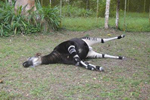
(07/05/2012) Officials have pointed to an infamous elephant poacher known as ‘Morgan’ as the head of the murderous attack at the Okapi Wildlife Reserve station in the Democratic Republic of the Congo (DRC) late last month. The attack by Morgan and his crew left seven people dead, including two wildlife rangers. The poachers also shot dead 13 captive okapis at the headquarters, which were considered ambassadors for the imperiled forest. One okapi remains alive, but injured and conservationists are not optimistic about its survival. UNESCO and the the NGO Fauna and Flora international have issued an emergency appeal to raise $120,000 dollars within two weeks for the victim’s families as well as for rapidly rebuilding the station.
Militia massacres rangers, 13 endangered okapi at Congo wildlife reserve
(06/29/2012) Two wildlife rangers were among the six people killed during brazen attack on a wildlife facility by a militia in the Democratic Republic of Congo last Sunday. 13 endangered okapi were slaughtered during the early morning raid, which was reportedly a response to a crackdown on illegal elephant poaching and gold mining inside the Okapi Wildlife Reserve.
Congolese experts needed to protect Congo Basin rainforests
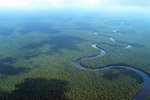
(06/20/2012) This summer, the Democratic Republic of Congo (DRC) is expected to approve a new higher education strategy which the country has developed with the World Bank and other international donors. The shape of this educational reform initiative will be critical to Congo’s future in many ways. It could finally offer Congo’s long-suffering people a route into the 21st century. It will also help determine the future of the DRC’s forests. Nearly half of the Congo Basin’s remaining rainforest is in the DRC—yet the critical role of Congolese experts in forestry, agricultural science, wildlife management and other rural sciences in protecting this forest is not widely recognized.
New armored lizard discovered in landmine-riddled region
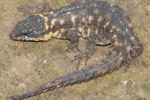
(05/21/2012) A new lizard has been discovered in a war-torn area of the Democratic Republic of the Congo (DRC). According to a paper in the African Journal of Herpetology